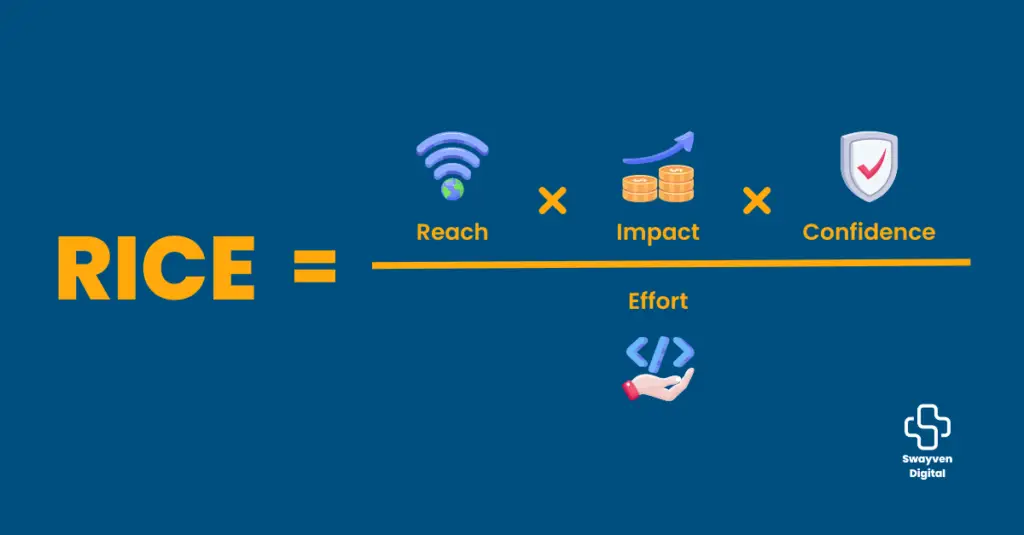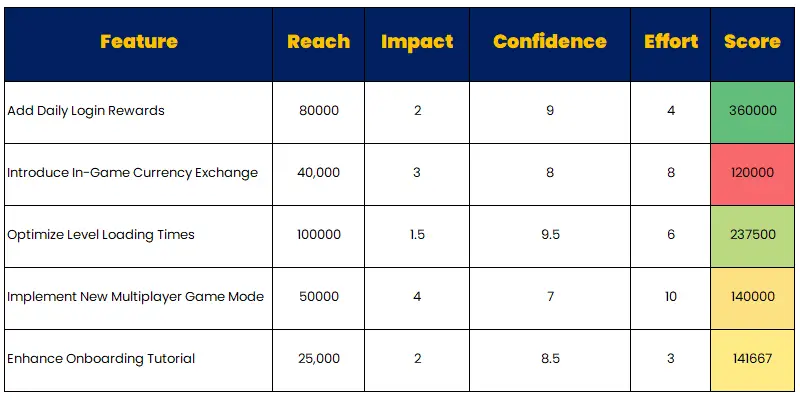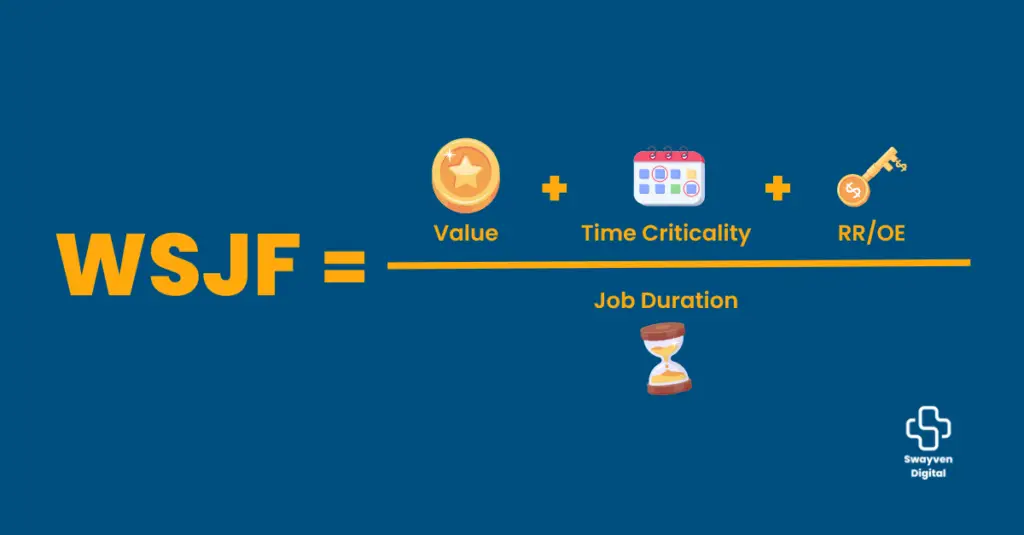Knowing how to effectively prioritize your game development projects is critical. Whilst every game studio has its unique vision, development bottlenecks and conflicting priorities can lead to delays or missed opportunities. To solve this, data-driven prioritization frameworks like Weighted Shortest Job First (WSJF) and RICE can be used to guide the studio and help ensure their resources are allocated effectively and their games remain competitive.
Let’s explore how these frameworks can be used to better prioritize your game development efforts.
Start with Clear Objectives and Establish KPIs
Before delving into the complexity of prioritization techniques, it’s essential to define clear objectives for your development projects. This starts with setting measurable KPIs that align with your broader business goals. Common KPIs in the gaming world include metrics like Daily Active Users (DAU), retention rates, Average Revenue Per User (ARPU), and in-game purchase conversion rates.
Data serves as the foundation for all prioritization frameworks. By linking KPIs directly to development projects, you ensure that you’re measuring progress toward your studio’s most critical objectives. This approach also clarifies which areas of the game need immediate focus, laying the groundwork for more sophisticated prioritization methods.
How to use the RICE Framework
The RICE framework is a powerful tool for prioritizing game development projects based on four key factors: Reach, Impact, Confidence & Effort.

- Reach: How many players will be affected by this feature or improvement? For example, will this change impact all players, or just a subset of highly engaged users?
- Impact: How significant will this change be in achieving your business goals, such as increasing retention or monetization? You can rank this on a scale (e.g., 0.25 for minimal impact, up to 3 for massive impact).
- Confidence: How confident are you in the data that supports this change? Higher confidence typically comes from features or changes validated through data analysis, A/B testing, or player feedback.
- Effort: How much time and resources will it take to implement the feature? Accurately estimating effort allows you to weigh it against potential benefits, preventing misallocation of resources.
To calculate a RICE score, multiply Reach, Impact, and Confidence, and then divide by Effort. The higher the score, the more priority that project or feature should have. This data-driven approach not only clarifies where to focus but also ensures you’re considering both impact and resource constraints, which is especially useful in games with multiple teams working on different areas simultaneously.
Below is a practical example of a RICE framework we used for one of our clients.

The specific scale you use for each dimension is flexible, as long as it is applied consistently across all features. In this example, we used the following scaling:
- Reach: Based on the estimated player count impacted.
- Impact: Rated from 1 (lowest) to 5 (highest), representing the degree to which the feature will influence your key objectives.
- Confidence: Scored from 1 (lowest) to 10 (highest), reflecting how certain you are in the data or assumptions behind the impact.
- Effort: Rated from 1 (lowest) to 10 (highest), estimating the amount of work required to implement the feature.
From this example, you can see that adding daily login rewards emerged as the highest priority. This is due to its strong Reach and Impact scores combined with relatively low Effort, making it a high-value feature to tackle first. Optimizing level loading times comes next, offering substantial benefits to the entire player base with a moderate level of effort. Enhancing the onboarding tutorial follows closely behind, showing a good balance of reach and effort.
On the other hand, introducing an in-game currency exchange ranks lowest in priority. Despite having a strong potential impact, its high effort and lower reach compared to other features mean that it should be deprioritized for now.
Following this approach provides a clear, data-driven approach to determining which features to focus on first, helping ensure that your resources are allocated effectively to maximize both player satisfaction and business outcomes.
How to use the WSJF Framework
The Weighted Shortest Job First (WSJF) method is another product management technique that excels in environments where rapid, iterative development is necessary—such as live ops. WSJF helps prioritize tasks by weighing the cost of delaying a project against the time it takes to complete it.

WSJF is calculated by dividing the Cost of Delay (CoD) by the Job Duration. The Cost of Delay (CoD) can be broken down into three factors:
- User/Business Value: How critical is the feature to player retention or monetization? For example, if a key feature is underperforming and leading to churn, its CoD is high.
- Time Criticality: How urgently does this feature need to be implemented to capitalize on a market trend or player demand? Seasonal content or limited-time events often have higher time criticality.
- Risk Reduction/Opportunity Enablement: Does this task mitigate risks (e.g., addressing a major bug) or open up new opportunities (e.g., enhancing cross-platform play)?
By using WSJF, game studios can ensure that high-value projects that deliver the most immediate impact are tackled first. This prioritization technique is particularly useful in live operations, where speed is crucial to maintaining player engagement.
Similar to the RICE example above, using a simple spreadsheet with the individual scores mapped out for each feature should suffice in implementing this framework to prioritise your live ops updates.
Leverage Data to Inform WSJF and RICE Scores
While both WSJF and RICE provide frameworks for prioritization, data is the linchpin that ensures these methods are applied effectively. Use your game analytics to feed directly into these calculations. For instance, in determining “Reach” in the RICE framework, analyze your player segmentation data to understand which cohorts are most affected by a specific feature. Similarly, when estimating “User/Business Value” in WSJF, use player churn data or lifetime value (LTV) predictions to quantify the cost of delay.
Analytics-backed scoring also allows you to validate assumptions about a feature’s impact, ensuring that prioritization is grounded in actual player behavior rather than intuition alone. Regularly updating your RICE and WSJF scores as more data becomes available ensures that your development roadmap remains aligned with evolving player needs and market conditions.
Use Predictive Analytics for Future Prioritization
Predictive analytics can offer a forward-looking view that helps studios stay ahead of player trends. As your analytics capabilities mature, you can leverage machine learning models to predict future player behaviors, such as churn likelihood, potential lifetime value, or expected in-game spending.
These predictive insights can then be fed back into frameworks like WSJF and RICE. For example, if a predictive model identifies a cohort of players likely to churn in the next 30 days, the feature aimed at retaining those players should have a much higher time criticality score under WSJF.
Similarly, predictive revenue data could inform the Impact component of the RICE score, ensuring your studio focuses on features that have the most potential to drive long-term profitability.
Integrate A/B Testing to Validate Hypotheses
Data-driven prioritization doesn’t end with scoring features. Once you’ve ranked your development projects, A/B testing can help validate those decisions. Controlled experiments allow you to test new features or changes on a subset of your player base, ensuring that they deliver the expected outcomes before full-scale implementation. For example, if RICE prioritizes a new monetization feature based on high Impact and Confidence, you can A/B test the feature to measure real-world player response.
This approach not only reduces the risk of rolling out features that underperform but also continually refines your prioritization process by feeding new data back into your decision-making frameworks.
Stay Agile with Rolling Prioritisation
The game development process is inherently fluid, especially with the rise of live services and evolving player expectations. Therefore, it’s essential to adopt a rolling prioritization system. Continuously updating your WSJF and RICE scores based on the latest data ensures your priorities stay aligned with both player behavior and business goals.
Additionally, adopting agile methodologies ensures that prioritization frameworks are regularly revisited. Holding sprint planning sessions where RICE and WSJF scores are recalibrated allows for a responsive development process that adapts to both internal insights and external market changes.
Final Thoughts
Using data to prioritize your game development projects is about more than just collecting information—it’s about applying it through structured frameworks that help you make smarter, faster decisions. Techniques like RICE and WSJF provide actionable methodologies for ensuring your studio is focusing on the projects that will drive the greatest impact, while predictive analytics and A/B testing offer deeper insights into player behaviour and future trends.
By continuously aligning your data with these prioritization techniques, your studio can make informed, confident decisions that enhance player experiences, boost profitability, and keep your game competitive in the fast-moving gaming market.
At Swayven Digital, we help studios turn data into actionable insights, build a culture of continuous improvement, and implement strategies that drive player engagement and profitability. If you’d like to learn more about our services and how we could assist you, please don’t hesitate to get in touch with us.
Stay tuned for more insights, and until next time, keep optimising!





